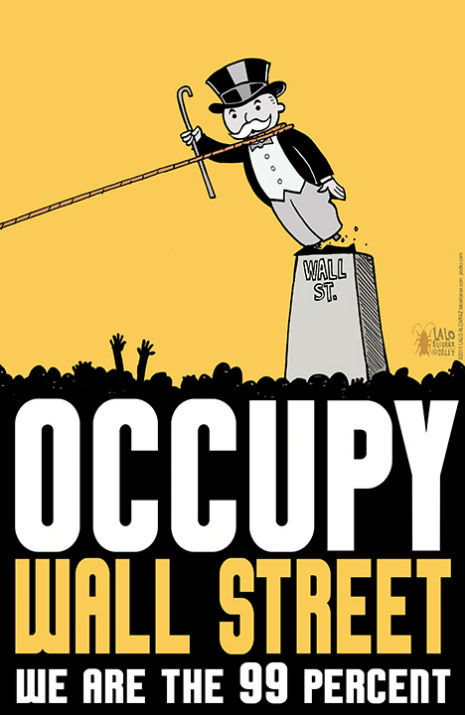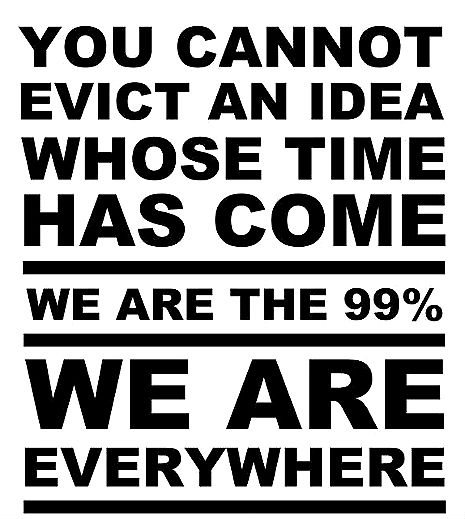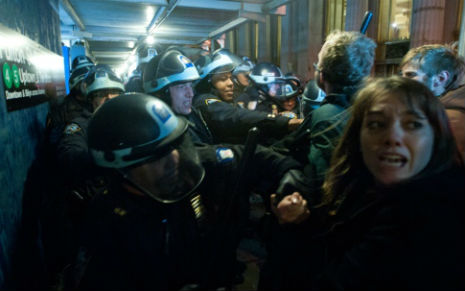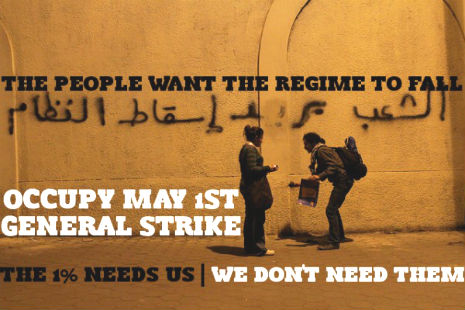
Occupy Wall Street poster by Lalo Alcaraz
Some pretty amazing images turning up on this live feed. How much of this is anyone seeing via the major media outlets? Other than The Guardian’s coverage, I ain’t seeing much at all.

Occupy Wall Street poster by Lalo Alcaraz
Some pretty amazing images turning up on this live feed. How much of this is anyone seeing via the major media outlets? Other than The Guardian’s coverage, I ain’t seeing much at all.

This is the transcript of a discussion that took place earlier this year between Noam Chomsky and Occupy supporters Mikal Kamil and Ian Escuela for InterOccupy, an organisation that provides links between supporters of the Occupy movement around the world.
Professor Chomsky, the Occupy movement is in its second phase. Three of our main goals are to: 1) occupy the mainstream and transition from the tents and into the hearts and the minds of the masses; 2) block the repression of the movement by protecting the right of the 99%‘s freedom of assembly and right to speak without being violently attacked; and 3) end corporate personhood. The three goals overlap and are interdependent.
We are interested in learning what your position is on mainstream filtering, the repression of civil liberties, and the role of money and politics as they relate to Occupy and the future of America.
Noam Chomsky: Coverage of Occupy has been mixed. At first it was dismissive, making fun of people involved as if they were just silly kids playing games and so on. But coverage changed. In fact, one of the really remarkable and almost spectacular successes of the Occupy movement is that it has simply changed the entire framework of discussion of many issues. There were things that were sort of known, but in the margins, hidden, which are now right up front – such as the imagery of the 99% and 1%; and the dramatic facts of sharply rising inequality over the past roughly 30 years, with wealth being concentrated in actually a small fraction of 1% of the population.
For the majority, real incomes have pretty much stagnated, sometimes declined. Benefits have also declined and work hours have gone up, and so on. It’s not third world misery, but it’s not what it ought to be in a rich society, the richest in the world, in fact, with plenty of wealth around, which people can see, just not in their pockets.
All of this has now been brought to the fore. You can say that it’s now almost a standard framework of discussion. Even the terminology is accepted. That’s a big shift.
Earlier this month, the Pew foundation released one of its annual polls surveying what people think is the greatest source of tension and conflict in American life. For the first time ever, concern over income inequality was way at the top. It’s not that the poll measured income inequality itself, but the degree to which public recognition, comprehension and understanding of the issue has gone up. That’s a tribute to the Occupy movement, which put this strikingly critical fact of modern life on the agenda so that people who may have known of it from their own personal experience see that they are not alone, that this is all of us. In fact, the US is off the spectrum on this. The inequalities have risen to historically unprecedented heights. In the words of the report: “The Occupy Wall Street movement no longer occupies Wall Street, but the issue of class conflict has captured a growing share of the national consciousness. A new Pew Research Center survey of 2,048 adults finds that about two-thirds of the public (66%) believes there are “very strong” or “strong” conflicts between the rich and the poor – an increase of 19 percentage points since 2009.”
Meanwhile, coverage of the Occupy movement itself has been varied. In some places – for example, parts of the business press – there has been fairly sympathetic coverage occasionally. Of course, the general picture has been: “Why don’t they go home and let us get on with our work?” “Where is their political programme?” “How do they fit into the mainstream structure of how things are supposed to change?” And so on.
And then came the repression, which of course was inevitable. It was pretty clearly coordinated across the country. Some of it was brutal, other places less so, and there has been kind of a stand-off. Some occupations have, in effect, been removed. Others have filtered back in some other form. Some of the things have been covered, like the use of pepper spray, and so on. But a lot of it, again, is just, “Why don’t they go away and leave us alone?” That’s to be anticipated.
The question of how to respond to it – the primary way is one of the points that you made: reaching out to bring into the general Occupation, in a metaphorical sense, to bring in much wider sectors of the population. There is a lot of sympathy for the goals and aims of the Occupy movement. They are quite high in polls, in fact. But that’s a big step short from engaging people in it. It has to become part of their lives, something they think they can do something about. So it’s necessary to get out to where people live. That means not just sending a message, but if possible, and it would be hard, to try to spread and deepen one of the real achievements of the movement that doesn’t get discussed much in the media – at least, I haven’t seen it. One of the main achievements has been to create communities – real functioning communities of mutual support, democratic interchange, care for one another, and so on. This is highly significant, especially in a society like ours in which people tend to be very isolated and neighbourhoods are broken down, community structures have broken down, people are kind of alone.
There’s an ideology that takes a lot of effort to implant: it’s so inhuman that it’s hard to get into people’s heads, the ideology to just take care of yourself and forget about anyone else. An extreme version is the Ayn Rand version. Actually, there has been an effort for 150 years, literally, to try to impose that way of thinking on people.
During the onset of the industrial revolution in eastern Massachusetts, mid-19th century, there happened to be a very lively press run by working people, young women in the factories, artisans in the mills, and so on. They had their own press that was very interesting, very widely read and had a lot of support. And they bitterly condemned the way the industrial system was taking away their freedom and liberty and imposing on them rigid hierarchical structures that they didn’t want. One of their main complaints was what they called “the new spirit of the age: gain wealth forgetting all but self”. For 150 years there have been massive efforts to try to impose “the new spirit of the age” on people. But it’s so inhuman that there’s a lot of resistance, and it continues.
One of the real achievements of the Occupy movement, I think, has been to develop a real manifestation of rejection of this in a very striking way. The people involved are not in it for themselves. They’re in it for one another, for the broader society and for future generations. The bonds and associations being formed, if they can persist and if they can be brought into the wider community, would be the real defence against the inevitable repression with its sometimes violent manifestations.
How best do you think the Occupy movement should go about engaging in these, what methods should be employed, and do you think it would be prudent to actually have space to decentralise bases of operation?
Noam Chomsky: It would certainly make sense to have spaces, whether they should be open public spaces or not. To what extent they should be is a kind of a tactical decision that has to be made on the basis of a close evaluation of circumstances, the degree of support, the degree of opposition. They’re different for different places, and I don’t know of any general statement.
As for methods, people in this country have problems and concerns, and if they can be helped to feel that these problems and concerns are part of a broader movement of people who support them and who they support, well then it can take off. There is no single way of doing it. There is no one answer.
You might go into a neighbourhood and find that their concerns may be as simple as a traffic light on the street where kids cross to go to school. Or maybe their concerns are to prevent people from being tossed out of their homes on foreclosures.
Or maybe it’s to try to develop community-based enterprises, which are not at all inconceivable – enterprises owned and managed by the workforce and the community which can then overcome the choice of some remote multinational and board of directors made out of banks to shift production somewhere else. These are real, very live issues happening all the time. And it can be done. Actually, a lot of it is being done in scattered ways.
A whole range of other things can be done, such as addressing police brutality and civic corruption. The reconstruction of media so that it comes right out of the communities, is perfectly possible. People can have a live media system that’s community-based, ethnic-based, labour-based and [reflecting] other groupings. All of that can be done. It takes work and it can bring people together.
Actually, I’ve seen things done in various places that are models of what could be followed. I’ll give you an example. I happened to be in Brazil a couple of years ago and I was spending some time with Lula, the former president of Brazil, but this was before he was elected president. He was a labour activist. We travelled around together. One day he took me out to a suburb of Rio. The suburbs of Brazil are where most of the poor people live.
They have semi-tropical weather there, and the evening Lula took me out there were a lot of people in the public square. Around 9pm, prime TV time, a small group of media professionals from the town had set up a truck in the middle of the square. Their truck had a TV screen above it that presented skits and plays written and acted by people in the community. Some of them were for fun, but others addressed serious issues such as debt and Aids. As people gathered in the square, the actors walked around with microphones asking people to comment on the material that had been presented. They were filmed commenting and were shown on the screen for other people to see it.
People sitting in a small bar nearby or walking in the streets began reacting, and in no time you had interesting interchanges and discussions among people about quite serious topics, topics that are part of their lives.
Well, if it can be done in a poor Brazilian slum, we can certainly do it in many other places. I’m not suggesting we do just that, but these are the kinds of things that can be done to engage broader sectors and give people a reason to feel that they can be a part of the formation of communities and the development of serious programmes adapted to whatever the serious needs happen to be.
From very simple things up to starting a new socio-economic system with worker- and community-run enterprises, a whole range of things is possible. The more active public support there is the better defence there is against repression and violence.
How do you assess the goals of the Democratic party as far as co-opting the movement, and what should we be vigilant and looking out for?
Noam Chomsky: The Republican party abandoned the pretence of being a political party years ago. They are committed, so uniformly and with such dedication, to tiny sectors of power and profit that they’re hardly a political party any more. They have a catechism they have to repeat like a caricature of the old Communist party. They have to do something to get a voting constituency. Of course, they can’t get it from the 1%, to use the imagery, so they have been mobilising sectors of the population that were always there, but not politically organised very well – religious evangelicals, nativists who are terrified that their rights and country are being taken away, and so on.
The Democrats are a little bit different and have different constituencies, but they are following pretty much the same path as the Republicans. The centrist Democrats of today, the ones who essentially run the party, are pretty much the moderate Republicans of a generation ago and they are now kind of the mainstream of the Democrat party. They are going to try to organise and mobilise – co-opt, if you like – the constituency that’s in their interest. They have pretty much abandoned the white working-class; it’s rather striking to see. So that’s barely part of their constituency at this point, which is a pretty sad development. They will try to mobilise Hispanics, blacks and progressives. They’ll try to reach out to the Occupy movement.
Organised labour is still part of the Democratic constituency and they’ll try to co-opt them; and with Occupy, it’s just the same as all the others. The political leadership will pat them on the head and say: “I’m for you, vote for me.” The people involved will have to understand that maybe they’ll do something for you, that only if you maintain substantial pressure can you get elected leadership to do things – but they are not going to do it on their own, with very rare exceptions.
As far as money and politics are concerned, it’s hard to beat the comment of the great political financier Mark Hanna. About a century ago, he was asked what was important in politics. He answered: “The first is money, the second one is money and I’ve forgotten what the third one is.”
That was a century ago. Today it’s much more extreme. So yes, concentrated wealth will, of course, try to use its wealth and power to take over the political system as much as possible, and to run it and do what it wants, etc. The public has to find ways to struggle against that.
Centuries ago, political theorists such as David Hume, in one of his foundations for government, pointed out correctly that power is in the hands of the governed and not the governors. This is true for a feudal society, a military state or a parliamentary democracy. Power is in the hands of the governed. The only way the rulers can overcome that is by control of opinions and attitudes.
Hume was right in the mid-18th century. What he said remains true today. The power is in the hands of the general population. There are massive efforts to control it by less force today because of the many rights that have been won. Methods now are by propaganda, consumerism, stirring up ethnic hatred, all kinds of ways. Sure, that will always go on but we have to find ways to resist it.
There is nothing wrong with giving tentative support to a particular candidate as long as that person is doing what you want. But it would be a more democratic society if we could also recall them without a huge effort. There are other ways of pressuring candidates. There is a fine line between doing that and being co-opted, mobilised to serve someone else’s interest. But those are just constant decisions and choices that have to be made.
Extracted from Occupy by Noam Chomsky, published by the Zuccotti Park Press and the Occupied Media Pamphlet Series in the US and Canada.

NYPD have a “discussion” with OWS protesters in 2011
Last night, several Occupy Wall Street activists were paid a visit at their homes by the NYPD who wanted to inquire about the activities they had planned for today’s mass protests. Gawker’s Adrian Chen reports that Gideon Oliver, the New York Chapter of the National Lawyers Guild’s president, told him, “They were asking what are your May Day plans, do you know who the leaders are—these are classic political surveillance questions.”
In the first case: activist Zachary Dempster said that six NYPD officers broke down the door of his Bushwick, Brooklyn apartment at around 6:15am this morning. Dempster said they were armed with a warrant for the arrest of his roommate, musician Joe Crow Ryan, for a six-year-old open container violation. But Dempster believes this was an excuse to check in on him, as he’d been arrested in February at an Occupy Wall Street Party that was broken up by cops, and charged with assaulting a police office and inciting a riot.
WTF? SIX COPS knocked this guy’s fucking door down for a SIX-YEAR-OLD OPEN CONTAINER VIOLATION??? Talk about a flimsy excuse for a SIX COP RAID!
They got a warrant and broke a door down because of a 2006 misdemeanor? (Or is it merely an infraction?) Remarkable!
That will teach that Communist hippie about cracking open a beer in public!
That they were able to secure a warrant to break the door down is something I hope to hear Mayor Bloomberg forced to explain…
After running his ID, a detective questioned Dempster in his bedroom for about five minutes about tomorrow’s May Day protest, he said.
“They asked what I was doing tomorrow, and if I knew of any activities, any events—that was how the conversation started,” Dempster said. Dempster said he’s not planning doing much, as his case from February is still open. Dempster’s roommate was also asked about him and May Day.
About an hour later, an activist friend of Dempster’s who runs in anarchist circles said his apartment in Bed-Stuy, Brooklyn, where he lives with a half-dozen other activists and Occupy Wall Street organizers was visited by six NYPD cops—possibly the same ones. The activist said police used arrest warrants for two men who no longer lived there as pretext for the raid. The officers ran the IDs of everyone who was in the apartment, then booked our source when they discovered he had an outstanding open container violation. Police never asked about Occupy Wall Street or May Day, but our source said the message was clear: We’re watching you.
Another open container violation? This is real “my dog ate my homework” shit, isn’t it? Open container violations! Imagine having your door knocked down by six police officers for a jay-walking ticket you didn’t pay.
“We obviously don’t think it’s an accident that it happened the day before May Day, where people in the house are organizers,” he said.
This afternoon, NYPD also visited the home of Greek anarchist artist Georgia Sagri, who has been part of Occupy Wall Street from the beginning and led the occupation of a SoHo art gallery last October. Turns out she was giving a press conference about May Day at Zuccotti Park at the time. Police waited for about an hour outside her home, then left.
“My roommate gave me a call and told me the NYPD was looking for me,” Sagri said. “Since that time, I didn’t go home. So I’m basically on the street. My May Day has already started which is fine, I don’t mind.” She said she has no idea why NYPD visited her.
This isn’t the first time NYPD has been criticized for aggressive surveillance of protesters: The NYPD infiltrated activist groups around the country before 2004’s New York Ciy Republican National Convention. And The New York Times has ably detailed the extent to which NYPD has harassed and spied on Occupy Wall Street protesters.
“The intention behind this I’m sure is to try to create fear and silence dissent,” said Marina Sitrin, a lawyer and member of Occupy Wall Street’s legal working group, “and to keep people from coming out into the streets.”
There are several marches, blockades and acts of civil disobedience planned across New York City today. From what I can tell via what precocious few media reports there have been, the rain is ending in the city and the protests are now starting to really gear up in Times Square, in front of Fox News and in the business district. If you can’t support the actions because you can’t get out of work, there is a mass rally expected in lower Manhattan after the work day.
Interesting to note (and I’m basing this observation from sampling through the live “Occupy Wall Street Superchannel” at UStream) the protests this time are more diffuse and spread out all over New York. Whereas it may not make for the same sort of TV-ready drama that attempts to close the Brooklyn Bridge off did last year, it makes the NYPD’s job a lot harder. You can “bottle,” contain and squeeze a large group, but it’s much harder to do anything about hundred of sites happening at once. Nice to see that the tactics are evolving.

Marxist anthropologist David Harvey talks to Democracy Now’s Amy Goodman about what to expect during tomorrow’s May Day protests.
On Tuesday, May 1st, known as May Day or International Workers Day, Occupy Wall Street protesters hope to mobilize tens of thousands of people across the country under the slogan, “General Strike. No Work. No Shopping. Occupy Everywhere.” Events are planned in 125 cities. We speak with leading social theorist David Harvey, distinguished professor of anthropology at the Graduate Center of the City University of New York, about how Occupy Wall Street compares to other large-scale grassroots movements throughout modern history.
“It’s struck a chord,” Harvey says of the Occupy movement. “I hope tomorrow there’ll be a situation in which many more people will say, ‘Look, things have got to change. Something different has to happen.’”
David Harvey’s latest book is Rebel Cities: From the Right to the City to the Urban Revolution.
Via Alternet

Enemies of the State.
I’m reading David Ray Carter’s well-researched and fascinating new book Conspiracy Cinema (release date: May 2) and was reminded that it was 19 years ago this month (April 19 to be exact) that 74 members of an offshoot of The Seventh-day Adventist Church (the Branch Davidians) were killed in the Texas town of Waco. More than 20 of them were below the age of 18.
Carter describes William Gazecki and Jason Van Vleet’s 1997 documentary Waco: Rules of Engagement as “surpassing most documentary cinema in its ability to appeal to both reason and emotion.”
Personally, emotion gets the best of me when it comes to Waco. I consider the slaughter of the Branch Davidians to be one of the most egregious cases of government-sanctioned murder (at least domestically) in American history. Every time I drive through Waco on my way from Austin to Dallas, I feel a cold chill and make a point of never stopping in that hellhole for gas or food. I was forced to stop there last year when a score of tornadoes ripped through the area. Tornadoes seem to be attracted to Waco. Perhaps it’s karma.
Transcript from an actual phone call between FBI hostage negotiator Jim Cavanaugh
and one of the Branch Davidians small children…...(children crying . . . rustling sound as
very young child picks up the phone) Child:
“Are you gonna come and kill me?”Cavanaugh:
“Hello? hello? No, honey… ” ( long pause then heavy sigh )....
“Nobody’s gonna come and kill you…..”
Child:
“Are you gonna come in and kill me?”
Well, somebody killed that small child and it is disgraceful that the tragedy at Waco seems to have been swept under the rug of our collective consciousness. Even back in 1993, as we watched the mass murder of 74 people on television, the immensity of what was taking place didn’t seem to register with most people. That we accepted it, that we kept quiet, that no one seemed to really care is astonishing. Yes, there were congressional hearings, but it all seemed to be for show, to divest ourselves of any guilt, any sense of shame, any fucking responsibility.
Representative John Conyers branded the April 19th gas and tank attack a “military operation” and called it a “profound disgrace to law enforcement in the United States.”
Representative Harold Volkmer charged the initial attack on the Branch Davidians was part of a pattern of “Gestapo-like tactics” at the bureau. “I fail to see the crimes committed by those in the Davidian compound that called for the extreme action of BATF on Feb. 28 and the tragic final assault.” Washington Post April 29, 1993
Watch Waco: Rules of Engagement and hope this never happens again. But don’t bet on it.
Watch Waco: A New Revelation after the jump…

I’ve been saying this for over a decade, and it’s becoming increasingly obvious with each passing year: The Republican Party, no matter what they do or how they position themselves, are basically toast after the 2012 election. Long predicted demographic trends that doom the GOP as a national majority party by 2016, are here NOW. And there is really nothing much they can do about it at this point.
Unless, of course, in November they take the White House, the Senate, hold on to the House and then ram thorough laws revoking the voting rights of anybody save for old white people who watch Fox News. If not, they’re fucked. and I mean fucked fucked. They know it, too.
There’s a not-so-silent subtext that comes through loud and clear in virtually all of the Republican messaging this year: “We’re desperate. Help us cement a wealthy Caucasian oligarchy in place before it’s too late and our way of life is finished!”
Well, good luck with that, assholes, as former Labor Secretary Robert Reich explains:
What are the three demographic groups whose electoral impact is growing fastest? Hispanics, women and young people. Who are Republicans pissing off the most? Latinos, women, and young people.
It’s almost as if the GOP can’t help itself.
Start with Hispanic voters, whose electoral heft keeps growing as they comprise an ever-larger portion of the electorate. Hispanics now favor President Obama over Romney by more than two to one, according to a recent Pew poll.
The movement of Hispanics into the Democratic camp has been going on for decades. What are Republicans doing to woo them back? Replicating California Republican Governor Pete Wilson’s disastrous support almost twenty years ago for Proposition 187 – which would have screened out undocumented immigrants from public schools, health care, and other social services, and required law-enforcement officials to report any “suspected” illegals. (Wilson, you may remember, lost that year’s election, and California’s Republican Party has never recovered.)
The Arizona law now before the Supreme Court – sponsored by Republicans in the state and copied by Republican legislators and governors in several others – would authorize police to stop anyone looking Hispanic and demand proof of citizenship. It’s nativism disguised as law enforcement.
Romney is trying to distance himself from that law, but it’s not working. That may be because he dubbed it a “model law” during February’s Republican primary debate in Arizona, and because its author (former state senator Russell Pearce, who was ousted in a special election last November largely by angry Hispanic voters) says he’s working closely with Romney advisers.
Hispanics are also reacting to Romney’s attack just a few months ago on GOP rival Texas Governor Rick Perry for supporting in-state tuition at the University of Texas for children of undocumented immigrants. And to Romney’s advocacy of what he calls “self-deportation” – making life so difficult for undocumented immigrants and their families that they choose to leave.
As if all this weren’t enough, the GOP has been pushing voter ID laws all over America, whose obvious aim is to intimidate Hispanic voters so they won’t come to the polls. But they may have the opposite effect – emboldening the vast majority of ethnic Hispanics, who are American citizens, to vote in even greater numbers and lend even more support to Obama and other Democrats.
And that’s just some of the ways the Republicans have gotten into hot water with Hispanic voters. Reich goes on to catalog more of the ridiculous missteps the GOP has made in recent memory when it comes to women and young voters. He concludes with a rhetorical question that he bluntly answers:
How can a political party be so dumb as to piss off Hispanics, women, and young people? Because the core of its base is middle-aged white men – and it doesn’t seem to know how to satisfy its base without at the same time turning off everyone who’s not white, male and middle-aged.
That’s it, in a nutshell, isn’t it? What a shitty balancing act to be forced into, but they did it to themselves. The key demographic, the slice of America that the GOP depends on the most is aging white people, especially older men, the same folks who still subscribe to newspapers and listen to talk radio. A demographic that is literally dying off.
Where will all the new Republicans come from to replace the old farts that are croaking in ever increasing numbers with each passing day/week/month/year? (I’d like to see some kind of time-lapse Koyaanisqatsi-esque visual treatment of that human erosion, wouldn’t you? Wouldn’t that be emotionally satisfying? I sure think it would be!)
So if you find yourself wondering why the overweening message coming from the GOP is so apocalyptic and why the rhetoric has turned so toxic in recent years, wonder no more, this election does indeed represent an apocalyptic turning point for the GOP. On a conscious level, they have to know this, but on a subconscious level, it also goes some way towards explaining the barely concealed racist and nativist undercurrents to the GOP message this year. This is a national election they can’t afford to lose, but fully expect that they will lose, just the same, so the language becomes more and more shrill and fantasies of forged birth certificates (or impeachment) become the last threads they can grasp at.
It’s pathetic, but I have no sympathy for them. The far-right in America is a lost cause, but luckily for the rest of us, one that’s clinging by its fingernails, demographically speaking.
Like I said, this time, they’re fucked fucked. Sit back and witness the real-time implosion of the Grand Old Party in 2012. It’s been a long time coming, but that long predicted future is now.
Read: The GOP’s Death Wish: Why Republicans Can’t Stop Pissing Off Hispanics, Women, and Young People

The future of the Republican Party

British artist Gerald Scarfe’s corrosive satire of Nixon-era America Long Drawn-Out Trip: Sketches from Los Angeles is an animated assault on the culture of greed, violence, the cult of celebrity and mass media that managed to piss off a lot of people when it was shown on BBC TV once in 1973. A combination of its harsh (though not inaccurate) depiction of the USA and problems obtaining the rights to the music on the soundtrack has kept this piece of cultural dynamite out of the public eye for four decades.
The subject of Long Drawn-Out Trip is Los Angeles and America itself, the concerns being the same ones that Ralph Steadman was depicting that year in his illustrations for Hunter S. “Thompson’s Fear and Loathing on the Campaign Trail ’72”: venality, violence, vulgarity and the omnipresent spectre of Richard Nixon, a president who had the good fortune to be drawn many times by two of Britain’s greatest living satirists although he wouldn’t have thanked them for it. In Scarfe’s film we also find Mickey Mouse being reduced to his constituent lines and colours after smoking a joint. The animated sequences for The Wall have their origin in this short film.” John Coulthart.
Scarfe recalls his first contact with members of Pink Floyd:
I did an animated film for the BBC in 1971 called Long Drawn-Out Trip. Roger and Nick (Mason) had seen it independently on BBC2 when it was aired. Roger told me that he rang Nick and said: “We’ve got to have this guy on board. He’s fucking mad.” Then Nick approached me and asked me to do an animation film and that’s how the relationship grew.
I first worked with them on their (1975) “Wish You Were Here” album then Roger came to my house and played me the first tapes of The Wall. He said he wanted to make an album, a show and a movie, all of which he accomplished.”
Scarfe on the genesis of his film:
I did a kind of stream of consciousness drawing everything I could think of about America at that time. Like, the Statue of Liberty, Frank Sinatra, John Wayne, Black Power, Mickey Mouse, Coca Cola, Playboy Magazine, sort of a million images all melting one into the other. I was supposed to be there for 10 days, but I stayed for about 6 or 7 weeks. Hence the title, Long Drawn-Out Trip. And it was also a kind of a trip, cause it was very much the drug era. And it was a kind of a hallucinatory trip too.
In addition to being a ferociously talented illustrator and cartoonist with an amazing past, Scarfe is married to one of the reigning queens of Sixties’ pop culture, Jane Asher.

NRA poster boy.
Appearing at a National Rifle Conference over the weekend, Romney surrogate, gunslinger and Colonel Sanders look-a-like Ted Nugent frothed at the mouth like a rabid dog proclaiming that if Barack Obama is re-elected in November, “I will either be dead or in jail by this time next year.” He also barked that Obama’s head should be chopped off (see video). Isn’t there a law against that?
Hey Ted, you vile piece of dinosaur shit, I hope to fuck that Obama is re-elected and you stay true to your words. I’ll stand in line to piss on your grave.
Update: New York Magazine reports that the Secret Service is aware of Nugent’s remarks and they’ve begun an investigation.

The medium is the message in Denver artist Andy Bell’s portrait of George Zimmerman made of 12,000 Skittles.
Zimmerman shot and killed Trayvon Martin, a black teenager who was armed with a cell phone, a bottle of tea, and a bag of Skittles.

In a rambling speech today before a group of onlookers in Gettysburg, Pennsylvania, Rick Santorum pulled out of the race for President…and the heavens wept.
In his typically brain-addled style, Santorum recalled some of the highlights of his campaign:
Even fun things like the sweater vest—amazing thing, that sweater vest. From then on the sweater vest became the official wardrobe of the Santorum campaign . . . We sourced that sweater vest to a company that was making them here in the United States.”
Expect the sweater vest-wearing, right-wing, religious zealot to re-emerge like the walking dead in 2016.